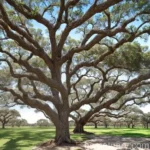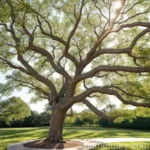Hungarian Oak (Quercus frainetto ‘Schmidt’ Forest Green): A Complete Guide
As a plant scientist, I have always been fascinated by the diversity and beauty of trees, and one particular species that has captured my attention is the Hungarian oak (Quercus frainetto ‘Schmidt’ Forest Green). This majestic tree is not only visually stunning but also offers numerous benefits and uses. In this comprehensive guide, we will delve into the various aspects of the Hungarian oak, including its cultural requirements, uses, maintenance, and much more.
What is the Hungarian Oak (Quercus frainetto ‘Schmidt’ Forest Green)?
The Hungarian oak, scientifically known as Quercus frainetto ‘Schmidt’ Forest Green, is a deciduous tree belonging to the Fagaceae family. It is native to Southeastern Europe, particularly Hungary, hence its common name. The tree’s distinctive features include its large, lobed leaves and a robust, spreading crown, making it a popular choice for landscaping and reforestation projects.
Key Takeaways
Before we delve deeper into the various aspects of the Hungarian oak, let’s explore some key takeaways about this remarkable tree:
- Scientific Name: Quercus frainetto ‘Schmidt’ Forest Green
- Common Name: Hungarian oak
- Family: Fagaceae
- Native Range: Southeastern Europe, particularly Hungary
- Distinctive Features: Large, lobed leaves and a robust, spreading crown
- Uses: Landscaping, reforestation, and ecological restoration
Now that we have a basic understanding of the Hungarian oak, let’s explore its cultural requirements, uses, and maintenance guidelines.
Culture
The cultural requirements of the Hungarian oak are essential to understand in order to ensure its successful growth and development. From water and sunlight needs to soil preferences, each aspect plays a crucial role in nurturing this tree.
Water
Proper watering is vital, especially during the tree’s establishment phase. The Hungarian oak prefers well-draining soil and thrives in moderate moisture conditions. However, it is crucial to avoid waterlogging, as excessively wet soil can lead to root rot and other issues.
A general guideline is to water the Hungarian oak deeply but infrequently, allowing the soil to dry out slightly between waterings. Once the tree is established, it exhibits good drought tolerance, making it suitable for landscapes with varying moisture levels.
Sunlight
Like many oak species, the Hungarian oak thrives in full sun to partial shade. It is important to provide adequate sunlight for the tree to develop a sturdy, well-structured crown. When selecting a planting location, consider the tree’s mature size and ensure that it will have access to sufficient sunlight throughout the day.
Soil
The Hungarian oak exhibits a preference for well-draining, slightly acidic to neutral soil. It can tolerate a range of soil types, including loam, clay, and sand, as long as the soil is not waterlogged. Adding organic matter to the soil during planting can help improve both drainage and nutrient availability, supporting healthy growth.
Uses
The Hungarian oak serves a variety of practical and aesthetic purposes, making it a valuable addition to landscapes and ecosystems.
Landscaping
Due to its impressive size, attractive foliage, and resilient nature, the Hungarian oak is a popular choice for landscaping in parks, gardens, and large estates. It serves as a focal point in the landscape, providing shade and visual appeal. The tree’s broad canopy also makes it suitable for creating natural shade structures in outdoor settings.
Reforestation and Ecological Restoration
In its native range and beyond, the Hungarian oak plays a key role in reforestation efforts and ecological restoration projects. Its ability to thrive in diverse soil and moisture conditions makes it well-suited for re-establishing wooded areas and supporting biodiversity. The tree’s acorns also provide a valuable food source for wildlife, contributing to the overall ecological balance.
Maintenance
Proper maintenance practices are essential for ensuring the health and vitality of the Hungarian oak. From fertilization and pruning to disease management, a proactive approach to maintenance can support the tree’s long-term well-being.
Fertilizer
When it comes to fertilizing the Hungarian oak, a balanced, slow-release fertilizer formulated for woody plants is recommended. Apply the fertilizer in early spring, just before new growth begins. Avoid over-fertilization, as this can lead to excessive vegetative growth at the expense of the tree’s overall health.
Pruning
Pruning is an important aspect of Hungarian oak maintenance, particularly during the early years to shape the tree’s growth. Remove any dead or diseased branches, and aim to create a well-spaced, balanced canopy. Pruning is best performed during the dormant season to minimize stress on the tree.
Propagation
Propagating the Hungarian oak can be accomplished through various methods, including seed propagation and vegetative propagation.
Seed Propagation
The Hungarian oak produces acorns, which serve as the tree’s seeds. To propagate the tree from seed, collect mature acorns in the fall and sow them in a well-draining seedling mix. Keep the soil consistently moist and provide adequate sunlight. Germination can occur within a few weeks to several months, and the resulting seedlings can be transplanted once they are established.
Vegetative Propagation
Vegetative propagation methods, such as hardwood cuttings and grafting, can also be used to propagate specific cultivars of the Hungarian oak. These methods allow for the preservation of desired traits and characteristics, ensuring uniformity in the resulting plants.
Container Popularity
The Hungarian oak is not commonly grown in containers due to its large size and deep-rooting nature. However, smaller cultivars or seedlings can be temporarily container-grown for a few years before being transplanted into the landscape.
Container Common Diseases
While the Hungarian oak is generally resilient, it can be susceptible to certain diseases. Understanding these potential issues is essential for proactive disease management.
Disease Diagnosis
Some common diseases that may affect the Hungarian oak include oak wilt, anthracnose, and powdery mildew. It is important to monitor the tree for signs of disease, such as leaf discoloration, wilting, or unusual growth patterns. Prompt diagnosis and appropriate intervention can help mitigate the impact of diseases on the tree’s health.
Common Pests
Pest infestations can also pose a threat to the Hungarian oak, though the tree is relatively resistant to many insect pests.
Insect Pests
Potential insect pests that may affect the Hungarian oak include oak borers, gypsy moths, and oak weevils. Regular monitoring of the tree’s foliage and bark can help detect early signs of pest activity, enabling timely intervention if necessary.
Botanist’s Tips
As a botanist, I have gathered useful tips for cultivating and caring for the Hungarian oak based on my research and practical experience with this species.
- Selecting the Planting Site: Choose a well-drained location with ample sunlight and sufficient space for the tree’s mature size.
- Watering: Water deeply but infrequently, especially during the tree’s establishment phase, and avoid waterlogging.
- Fertilization: Use a balanced, slow-release fertilizer in early spring, avoiding over-fertilization to prevent excessive vegetative growth.
- Pruning: Perform pruning during the dormant season to shape the tree’s growth and maintain a well-spaced canopy.
- Disease Management: Monitor the tree for signs of disease and implement appropriate interventions, such as targeted treatments or cultural practices to reduce disease pressure.
Fun Facts
- The Hungarian oak is known for its ability to adapt to various soil and moisture conditions, making it a resilient choice for diverse landscapes.
- The tree’s acorns serve as a valuable food source for wildlife, contributing to the ecological balance in wooded areas.
- Over time, the Hungarian oak develops a robust, spreading crown, providing ample shade and visual interest in the landscape.
Links to External Resources
For further information about the Hungarian oak and related topics, I recommend exploring the following external resources:
- The Morton Arboretum: Hungarian Oak (Quercus frainetto)
- Royal Horticultural Society: Quercus frainetto ‘Schmidt’
- University of Florida IFAS Extension: Quercus frainetto Forest Green
In conclusion, the Hungarian oak (Quercus frainetto ‘Schmidt’ Forest Green) is a remarkable tree species with a range of uses and benefits, from landscaping to ecological restoration. By understanding its cultural requirements, maintenance guidelines, and potential challenges, we can promote the successful growth and longevity of this iconic tree. I hope this comprehensive guide has provided valuable insights into the characteristics and care of the Hungarian oak, inspiring a greater appreciation for this magnificent species.
Keywords: Hungarian oak tree, Quercus frainetto Schmidt, Forest Green Hungarian oak, Hungarian oak plant, Quercus frainetto Forest Green, Schmidt Hungarian oak, Hungarian oak species, Hungarian oak cultivation, Quercus frainetto varieties, Forest Green oak tree, Hungarian oak characteristics, Quercus frainetto ‘Schmidt’ information, Forest Green oak facts, Hungarian oak care tips, Quercus frainetto ‘Schmidt’ cultivation guide, Forest Green oak benefits, Hungarian oak for landscaping, Quercus frainetto Schmidt tree, Forest Green oak plant details, Hungarian oak maintenance, Quercus frainetto Schmidt features, Forest Green oak tree varieties, Hungarian oak planting guide, Quercus frainetto ‘Schmidt’ growth habits, Forest Green oak tree care, Hungarian oak uses, Quercus frainetto Schmidt characteristics, Forest Green oak tree species, Hungarian oak tree facts, Quercus frainetto ‘Schmidt’ landscaping ideas, Forest Green oak tree benefits, Hungarian oak tree care instructions, Quercus frainetto Schmidt growing conditions, Forest Green oak tree plantation, Hungarian oak tree varieties, Quercus frainetto ‘Schmidt’ tree features, Forest Green oak tree planting tips, Hungarian oak tree maintenance, Quercus frainetto Schmidt care guidelines, Forest Green oak tree facts and uses, Hungarian oak tree landscape design, Quercus frainetto ‘Schmidt’ tree benefits, Forest Green oak tree care requirements, Hungarian oak tree growth habits, Quercus frainetto Schmidt planting instructions, Forest Green oak tree species details, Hungarian oak tree care essentials, Quercus frainetto ‘Schmidt’ tree characteristics, Forest Green oak tree landscaping benefits, Hungarian oak tree care suggestions















